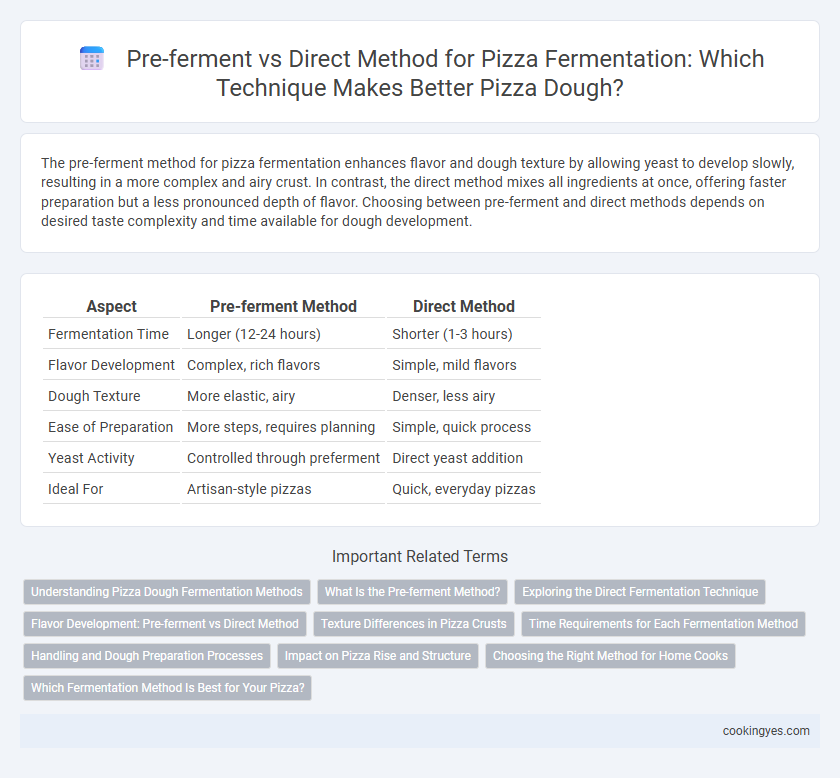The pre-ferment method for pizza fermentation enhances flavor and dough texture by allowing yeast to develop slowly, resulting in a more complex and airy crust. In contrast, the direct method mixes all ingredients at once, offering faster preparation but a less pronounced depth of flavor. Choosing between pre-ferment and direct methods depends on desired taste complexity and time available for dough development.
Table of Comparison
| Aspect | Pre-ferment Method | Direct Method |
|---|---|---|
| Fermentation Time | Longer (12-24 hours) | Shorter (1-3 hours) |
| Flavor Development | Complex, rich flavors | Simple, mild flavors |
| Dough Texture | More elastic, airy | Denser, less airy |
| Ease of Preparation | More steps, requires planning | Simple, quick process |
| Yeast Activity | Controlled through preferment | Direct yeast addition |
| Ideal For | Artisan-style pizzas | Quick, everyday pizzas |
Understanding Pizza Dough Fermentation Methods
Pre-ferment fermentation involves preparing a portion of the dough in advance, allowing yeast to develop flavor and improve texture through extended fermentation time, which enhances the crust's complexity and chewiness. The direct method mixes all ingredients at once and proceeds with a shorter fermentation, resulting in a faster rise but a less developed flavor profile and texture. Mastering these fermentation techniques is crucial for achieving desired pizza characteristics, with pre-ferment favored by artisan pizzerias for its depth of flavor and direct method preferred for quick, consistent production.
What Is the Pre-ferment Method?
The pre-ferment method involves fermenting a portion of the dough ingredients separately before mixing them into the final dough, enhancing flavor complexity and dough strength. This technique typically uses types like poolish or biga, which develop natural yeast activity and organic acids over several hours. Bakers prefer the pre-ferment method for producing pizza crusts with improved texture, enhanced aroma, and better fermentation control compared to the direct method.
Exploring the Direct Fermentation Technique
The direct fermentation technique for pizza dough involves mixing all ingredients at once, allowing yeast to ferment the dough in a single step, which accelerates production and simplifies the process. This method produces a dough with a slightly denser texture and a more straightforward flavor profile compared to pre-ferment techniques like poolish or biga, which develop complex flavors over extended fermentation. Direct fermentation is ideal for pizzerias seeking quick turnaround times while maintaining consistent crust quality and dough extensibility.
Flavor Development: Pre-ferment vs Direct Method
Pre-ferment enhances pizza dough flavor by allowing yeast fermentation to develop complex, aromatic compounds and organic acids, resulting in a richer, tangier taste. The direct method produces a simpler, more straightforward flavor due to shorter fermentation times and less enzymatic activity. Bakers seeking depth and character in pizza crust typically prefer pre-ferment for superior flavor development.
Texture Differences in Pizza Crusts
The pre-ferment method enhances pizza crust texture by developing complex gluten structures and organic acids, resulting in a chewier and more flavorful crust with improved aeration. In contrast, the direct method produces a softer and less textured crust due to shorter fermentation times and limited flavor development. Bakers seeking a crispy, airy crust prefer the pre-ferment approach, while the direct method suits quick turnaround and softer textures.
Time Requirements for Each Fermentation Method
The pre-ferment method requires extended fermentation time, often ranging from 12 to 72 hours, allowing complex flavor development and improved dough texture through a slow yeast activity process. In contrast, the direct method completes fermentation in a shorter period, typically 1 to 3 hours, speeding up dough preparation but producing less depth in flavor and chewiness. Choosing between these methods depends on balancing available preparation time with desired dough characteristics in artisanal pizza baking.
Handling and Dough Preparation Processes
Pre-ferment fermentation involves creating a starter dough that ferments before being mixed with the final ingredients, enhancing flavor complexity and dough extensibility while requiring longer preparation and careful handling to maintain yeast activity. The direct method mixes all ingredients simultaneously, streamlining dough preparation with faster processing times but resulting in less developed flavors and a denser texture. Effective dough handling in the pre-ferment method includes gentle folding and controlled fermentation temperature, whereas the direct method emphasizes rapid kneading and consistent hydration for optimal gluten development.
Impact on Pizza Rise and Structure
The pre-ferment method enhances pizza rise by allowing yeast to develop flavor and gas production slowly, resulting in a more open crumb structure and improved dough elasticity. In contrast, the direct method produces a quicker rise but often yields a denser crust with less complex texture. Pre-fermented doughs exhibit better oven spring and a chewier, airier crumb, ideal for traditional Neapolitan-style pizzas.
Choosing the Right Method for Home Cooks
Home cooks selecting between the pre-ferment and direct methods for pizza fermentation should consider timing, flavor depth, and dough texture. The pre-ferment method, which involves fermenting a portion of the dough ahead, enhances flavor complexity and improves crust texture, ideal for those who can start preparation early. Conversely, the direct method suits quick preparation, mixing all ingredients at once for a faster rise but with less developed flavor and chew.
Which Fermentation Method Is Best for Your Pizza?
Choosing the best fermentation method for pizza depends on your desired crust texture and flavor complexity. Pre-ferment methods like poolish or biga develop deeper, tangier flavors and a chewier texture due to extended fermentation and yeast activity. The direct method is faster and simpler, resulting in a milder taste and softer crust, ideal for quick preparation without sacrificing dough quality.
Pre-ferment vs Direct method for pizza fermentation Infographic

 cookingyes.com
cookingyes.com